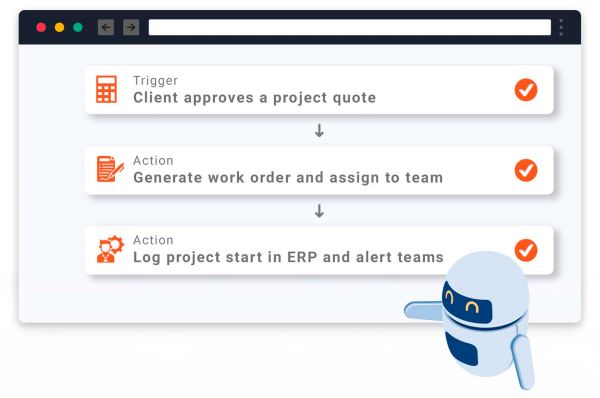
How to Automate Business with AI
Table of Contents
- Identifying Automation Opportunities in Your Business
- Types of AI Technologies Used in Business Automation
- How to Get Started with AI Automation
- Building an AI-Ready Team
- Case Studies of Successful AI Automation
- Measuring the ROI of AI Automation
- Future Trends in AI Business Automation
- FAQs
- Conclusion

AI business automation is transforming business operations across industries. It helps companies cut costs, speed up processes, and make smarter decisions with less effort. From customer support to marketing to logistics, AI Business solutions are eliminating repetitive tasks and freeing up time for more strategic work. It’s not just about working faster—it’s about working smarter. With automation tools becoming more accessible and affordable, even small businesses can harness AI to streamline their operations and compete with larger players.
Key Takeaways
- AI helps automate repetitive tasks and improve decision-making across departments.
- Start with simple automation opportunities and scale based on ROI and impact.
- Use tools like chatbots, machine learning, and RPA depending on your needs.
- Train your team and create a culture that embraces AI, not fears it.
- Monitor results with clear KPIs to ensure continued improvement and value.
Identifying Automation Opportunities in Your Business
The first step in AI business automation is figuring out where it can help the most. You need to find processes that are repetitive, data-driven, and time-consuming. By auditing your workflows, you’ll quickly identify tasks that waste time or are prone to human error. Employees often know where inefficiencies exist, so involve them in this discovery phase. Evaluate your customer journey, internal operations, and data flows. Focus on areas where automation would lead to noticeable time savings or improved service.
Types of AI Technologies Used in Business Automation
AI tools come in many forms, and understanding their capabilities will help you choose the right ones. Businesses use a combination of technologies to build automation strategies that suit their needs.
- Machine Learning (ML): For pattern recognition, forecasting, and data analysis.
- Natural Language Processing (NLP): To power chatbots, sentiment analysis, and document scanning.
- Robotic Process Automation (RPA): Automates repetitive computer-based tasks like data transfers and reporting.
- AI Chatbots: Provide instant responses to customer queries and reduce service workload.
Each tool serves a different purpose, and together, they can replace hours of manual labor with seamless automation.
How to Get Started with AI Automation
Jumping into AI can seem complex, but breaking it down into actionable steps makes the transition smoother. Start by defining what you want to automate and why. Whether your goal is faster customer support or more accurate forecasting, having a clear objective helps you measure results. Identify simple processes first—those with low complexity but high impact. Choose tools that match your technical capacity and budget. Don’t worry about building something complex right away. Start small, run a pilot project, gather feedback, and then refine before scaling. The key is progress, not perfection.
Building an AI-Ready Team
AI business automation doesn’t replace your team—it enhances it. But to unlock its full value, your team needs to be prepared. That starts with training. Offer resources and learning opportunities so employees can understand how AI tools work and how they can benefit. Encourage a culture of curiosity and experimentation. Appoint internal champions who can guide others and troubleshoot basic issues. The more familiar your team becomes with AI, the more confident they’ll be using it day to day. This is how automation becomes part of your company’s DNA rather than just another tech initiative.
Case Studies of Successful AI Automation
Across industries, AI business automation is delivering impressive results. In retail, companies like Amazon use AI to optimize inventory and tailor product recommendations in real-time. In healthcare, AI is speeding up diagnostics, predicting patient outcomes, and managing medical records more efficiently. The finance industry uses AI to detect fraud, assess credit risk, and enhance customer service through virtual assistants. These real-world examples prove that AI isn’t just for tech giants. Businesses of all sizes can automate intelligently and reap significant benefits by starting small and scaling fast.
Measuring the ROI of AI Automation
To understand whether your AI investment is paying off, you need to track performance using meaningful metrics. Focus on quantifiable improvements and real-world outcomes.
Here are a few KPIs to monitor:
- Time saved per process or task
- Cost reductions in labor and operations
- Accuracy improvements (e.g., fewer errors or complaints)
- Customer satisfaction and retention
- Increased revenue or conversions
Use visualization tools like Power BI or Tableau to monitor trends and identify areas for further optimization. Consistent tracking turns insights into action and ensures your automation evolves over time.
Future Trends in AI Business Automation
AI is advancing rapidly, and businesses that want to stay ahead must embrace upcoming trends. One key development is the fusion of AI with IoT (Internet of Things). Smart devices now generate data that AI uses to automate processes in real-time—like smart warehouses adjusting climate or inventory based on usage patterns. Another major shift is toward fully autonomous business processes. These are systems that manage tasks without any human involvement—think marketing campaigns that adjust themselves or supply chains that self-correct in response to delays. The future is moving toward self-optimizing, always-on operations.
FAQs
What’s the easiest way to start automating a business with AI?
Begin with one or two repetitive processes and automate using simple tools like chatbots or Zapier. No coding required.
Is AI automation affordable for small businesses?
Yes. Many platforms offer low-cost, no-code options that are ideal for startups and small teams.
Are AI tools safe for sensitive data?
They can be—if you use secure, compliant platforms and maintain proper data handling practices.
Will AI take over all jobs?
AI will replace certain tasks but also create new roles. The future workforce will focus more on strategy, creativity, and problem-solving.
Do I need a tech team to use AI?
Not necessarily. Many AI tools are designed for business users with no coding experience.
Conclusion
AI business automation is no longer just a futuristic concept—it’s a competitive advantage available today. By identifying the right areas, choosing the appropriate tools, and preparing your team, you can transform your operations without a complete overhaul. The result? Faster processes, fewer errors, happier customers, and a stronger bottom line. The best part is, AI Business solutions are scalable—you can start small and grow at your own pace. Businesses that embrace AI now are setting themselves up not just for survival, but for sustained success in a tech-driven world.
To learn more about how Optimum can guide you in this endeavor, fill out our Consultation Form.